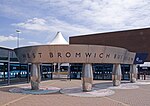Lodge Road West Bromwich Town Hall tram stop
Railway stations in Great Britain opened in 1999Tram stops in SandwellUnited Kingdom tram stubsUse British English from March 2017West Bromwich

Lodge Road West Bromwich Town Hall tram stop is a tram stop at the western edge of West Bromwich town centre in the West Midlands, England. It was opened on 31 May 1999 and is situated on West Midlands Metro Line 1. The stop is located in a deep cutting, and a lift has been installed to take passengers to and from street level, as well as a spiral walkway. In 2015/16 it was the least used stop on Line 1.
Excerpt from the Wikipedia article Lodge Road West Bromwich Town Hall tram stop (License: CC BY-SA 3.0, Authors, Images).Lodge Road West Bromwich Town Hall tram stop
West Bromwich Parkway, Sandwell
Geographical coordinates (GPS) Address Nearby Places Show on map
Geographical coordinates (GPS)
| Latitude | Longitude |
|---|---|
| N 52.51865 ° | E -1.99987 ° |
Address
Lodge Road, West Bromwich Town Hall
West Bromwich Parkway
B70 8EP Sandwell
England, United Kingdom
Open on Google Maps







